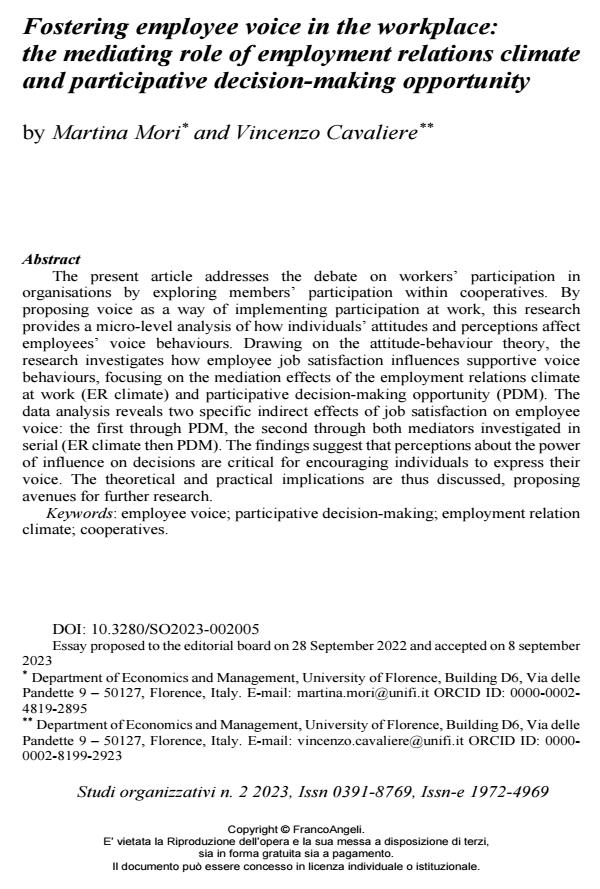Fostering employee voice in the workplace: the mediating role of employment relations climate and participative decision-making opportunity
Titolo Rivista STUDI ORGANIZZATIVI
Autori/Curatori Martina Mori, Vincenzo Cavaliere
Anno di pubblicazione 2024 Fascicolo 2023/2
Lingua Inglese Numero pagine 32 P. 105-136 Dimensione file 361 KB
DOI 10.3280/SO2023-002005
Il DOI è il codice a barre della proprietà intellettuale: per saperne di più
clicca qui
Qui sotto puoi vedere in anteprima la prima pagina di questo articolo.
Se questo articolo ti interessa, lo puoi acquistare (e scaricare in formato pdf) seguendo le facili indicazioni per acquistare il download credit. Acquista Download Credits per scaricare questo Articolo in formato PDF

FrancoAngeli è membro della Publishers International Linking Association, Inc (PILA)associazione indipendente e non profit per facilitare (attraverso i servizi tecnologici implementati da CrossRef.org) l’accesso degli studiosi ai contenuti digitali nelle pubblicazioni professionali e scientifiche
The present article addresses the debate on workers’ participation in organisations by exploring members’ participation within cooperatives. By proposing voice as a way of implementing participation at work, this research provides a micro-level analysis of how individuals’ attitudes and perceptions affect employees’ voice behaviours. Drawing on the attitude-behaviour theory, the research investigates how employee job satisfaction influences supportive voice behaviours, focusing on the mediation effects of the employment relations climate at work (ER climate) and participative decision-making opportunity (PDM). The data analysis reveals two specific indirect effects of job satisfaction on employee voice: the first through PDM, the second through both mediators investigated in serial (ER climate then PDM). The findings suggest that perceptions about the power of influence on decisions are critical for encouraging individuals to express their voice. The theoretical and practical implications are thus discussed, proposing avenues for further research.
Il presente articolo affronta il dibattito sulla partecipazione dei lavoratori nelle organizzazioni esplorando la partecipazione dei membri all’interno delle organizzazioni cooperative. Proponendo la voce come modalità di partecipazione sul lavoro, questa ricerca esplora a livello micro come le attitudini e le percezioni degli individui influenzano i comportamenti di voice sul lavoro. Sulla base della Attitude-Behaviour Theory, la ricerca indaga come la soddisfazione lavorativa dei dipendenti influenzi i comportamenti di voice supportiva, concentrando l'attenzione sugli effetti di mediazione del clima organizzativo riguardo le relazioni di lavoro e delle opportunità decisionali partecipative (PDM). L'analisi empirica rivela due effetti indiretti specifici della soddisfazione lavorativa sulla voce dei dipendenti: il primo attraverso il PDM, il secondo attraverso entrambi i mediatori indagati in serie (clima delle relazioni di lavoro e poi PDM). I risultati suggeriscono che le percezioni riguardanti il potere di influenza sulle decisioni sono cruciali per incoraggiare gli individui a esprimere la propria voce a lavoro. Le conseguenti implicazioni teoriche e pratiche sono quindi discusse, proponendo alcune riflessioni sulle potenziali ricerche future.
Parole chiave:voce dei dipendenti; decision-making partecipativo; relazioni di lavoro; organizzazioni cooperative.
Martina Mori, Vincenzo Cavaliere, Fostering employee voice in the workplace: the mediating role of employment relations climate and participative decision-making opportunity in "STUDI ORGANIZZATIVI " 2/2023, pp 105-136, DOI: 10.3280/SO2023-002005